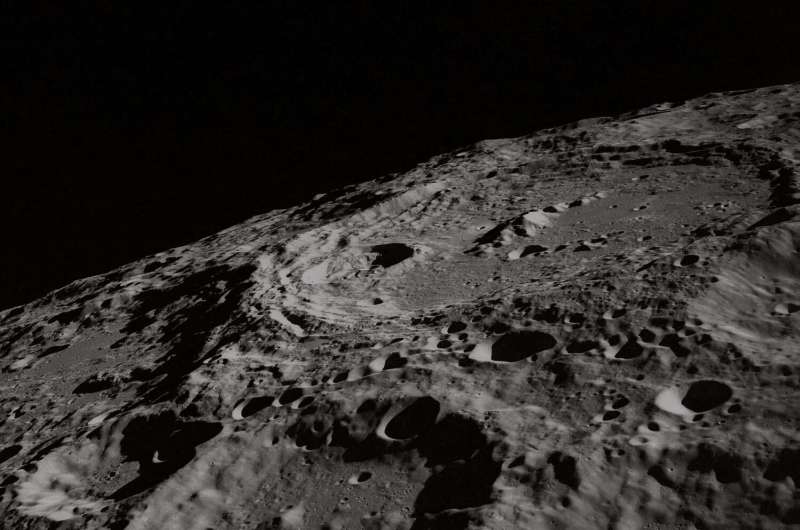Making the moon: Study details new story for how the moon formed

Simon Lock wants to change the way you think about the Moon.
A graduate student in Harvard's Department of Earth and Planetary Sciences, Lock is the lead author of a study that suggests the Moon - rather than being spun out of the aftermath of a collision - emerged from a massive, donut-shaped cloud of vaporized rock called a synestia.
Along with Lock, the study, published February 28 in Journal of Geophysical Research: Planets, is co-authored by Sarah Stewart (UC Davis), Michail Petaev (Harvard), Zoë Leinhardt (Bristol), Mia Mace (Bristol), Stein Jacobsen (Harvard), and Matija Ćuk (SETI).
"The commonly accepted theory as to how the Moon was formed is that a Mars sized body collided with the proto-Earth and spun material into orbit," Lock said. "That mass settled into a disk and later accreted to form the moon. The body that was left after the impact was the Earth. This has been the canonical model for about 20 years."
It's a compelling story, Lock said, and it's also probably not correct.
"Getting enough mass into orbit in the canonical scenario is actually very difficult, and there's a very narrow range of collisions that might be able to do it," he said. "There's only a couple of degree window of impact angles and a very narrow range of sizes...and even then some impacts still don't work."
"This new work explains features of the Moon that are hard to resolve with current ideas," said Stewart, a professor of Earth and Planetary Sciences at UC Davis. "This is the first model that can match the pattern of the Moon's composition."
What's more, he said, tests have shown that the isotopic "fingerprint" for both the Earth and Moon are nearly identical, suggesting both came from the same source. But in the canonical story, the Moon formed mostly from the remnants of just one of the two bodies that collided.
But just as similarities between the Earth and Moon raise questions about the accepted story for the Moon's creation, so too do their differences.
Tests have shown that the Moon is far less abundant in many volatile elements - such as potassium, sodium and copper - that are relatively common on Earth.
"There hasn't been a good explanation for this," Lock said. "People have proposed various hypotheses for how the Moon could have wound up with fewer volatiles, but no one has been able to quantitatively match the Moon's composition."
The scenario outlined by Lock and colleagues still begins with a massive collision, but rather than creating a disc of rocky material, the impact creates a synestia.
"It's huge," Lock said. "It can be ten times the size of the Earth, and because there's so much energy in the collision, maybe 10 percent of the rock of Earth is vaporized, and the rest is liquid...so the way you form the Moon out of a synestia is very different."
It begins with a "seed" - a small amount of liquid rock that gathers just off the center of the donut-like structure. As the structure cools, vaporized rock condenses and rains down toward the center of the synestia. Some of the rain runs into the Moon, causing it to grow.
"The rate of rain fall is about ten times that of a hurricane on Earth," Lock said. "Over time, the whole structure shrinks, and the Moon emerges from the vapor. Eventually, the whole synestia condenses and what's left is a ball of spinning liquid rock that eventually forms the Earth as we know it today."
The whole process happens remarkably fast, with the Moon emerging from the synestia in just a few tens of years, and the Earth forming about 1,000 years later.
More importantly, Lock said, it addresses each of the problems with the canonical model for the Moon's creation. Since both the Earth and Moon are created from the same cloud of vaporized rock, they naturally share similar isotope "fingerprints." The lack of volatile elements on the Moon, meanwhile, can be explained by the fact that the Moon formed surrounded by tens of atmospheres of vapor and at temperature of 4000-6000 Fahrenheit.
"Basically, this is the first model that that has been able to explain the complications, and that has been able to do it quantitatively," Lock said. "This is a dramatically different way of forming the Moon. You just don't think of a satellite forming inside another body, but this is what appears to happen."
While the model appears to address some long-standing questions regarding the creation of the Moon, Lock said the work is still in its preliminary stages, and more work must be done to refine the model further.
"This is a basic model," Lock said. "We've done calculations of each of the processes that go into forming the Moon and shown that the model could work, but there are various aspects of our theory that will need more interrogation.
"For example, when the Moon is in this vapor, what does it do to that vapor? How does it perturb it? How does the vapor flow past the Moon? These are all things we need to go back and examine in more detail."
More information: Simon J. Lock et al. The origin of the Moon within a terrestrial synestia, Journal of Geophysical Research: Planets (2018). DOI: 10.1002/2017je005333
Provided by Harvard University




















